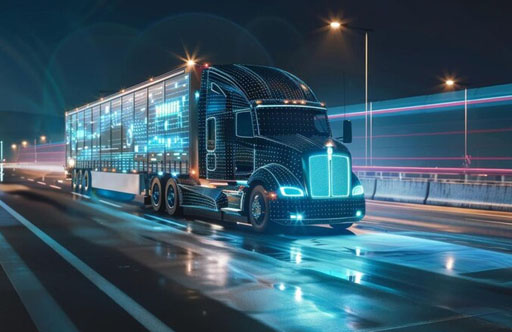Embracing Autonomous Trucks: How Load Connex Is Preparing for the Driverless Semi-Trucking Future
Autonomous trucking is no longer theoretical, it is a fast-approaching reality, especially in long-haul operations involving semi-trucks (18-wheelers). At Load Connex, we believe that while full autonomy is possible and even likely over time, widespread deployment across all legs of freight movement remains further down the road. For now, a hybrid model, where AI-powered autonomous trucks handle long-haul freeway routes and human drivers manage complex urban and terminal operations, is the most realistic path forward.

Our platform is built for this transition. With multi-carrier, multi-leg capabilities and an intelligent, data-driven marketplace, Load Connex is already positioned to support freight workflows that involve both human and autonomous assets.
The Near-Term Future: A Hybrid Model for Semi-Truck Operations
Highways Are Ready for Autonomy
In the near future, autonomously driven semi-trucks will be widely used on highways. These controlled, consistent environments are ideal for AI and sensor-based driving systems. Autonomous trucks can safely manage long-haul routes from freeway on-ramp to off-ramp without human intervention.
Why Urban Driving Still Requires Humans
Maneuvering a large, articulated vehicle like an 18-wheeler through urban streets, shipper yards, or congested delivery zones remains a significant challenge. These environments are unpredictable and require precision navigation, human judgment, and interaction with personnel on-site.Additionally, common industry practices like drop-and-hook operations, require a driver to manually detach from one trailer and attach to another, as well as perform visual checks and coordinate with facility staff. These tasks cannot yet be reliably performed by autonomous trucks.
As a result, the industry is moving toward a hybrid approach:
- Driverless trucks manage the long-haul highway segments
- Human drivers handle local pickups, drop-offs, and trailer transitions
Market Segmentation: Big Carriers Will Lead Autonomy, Small Carriers Will Own the Local Leg
While autonomous trucking presents tremendous opportunity, it also requires significant capital investment, access to advanced technology, and deep integration with AI and sensor systems. For these reasons, we believe:
- Larger carriers with deeper resources and advanced fleet capabilities are best positioned to adopt and operate autonomous trucks at scale, particularly on long-haul corridors
At the same time:
- Smaller carriers and owner-operators are expected to remain dominant in the local, urban, and final-mile segments where autonomy has limited reach. These drivers offer flexibility, direct shipper relationships, and the human skill needed for tight delivery windows and complex trailer maneuvers
This dual structure makes coordination between large and small fleets essential for the future of freight. Load Connex is designed to enable that coordination.
Expanding Freight Modalities to Include Autonomy
The freight industry traditionally classifies transport by mode, such as Truck, Rail, Ocean, and Air. Within trucking, the emergence of autonomy introduces a new operational layer:
- Autonomous Semi-Trucks for highway-only legs
- Human-Driven Semi-Trucks for local and urban legs
- Rail
- Ocean
- Air
As autonomous trucks become more cost-effective, conservatively estimated at 30 percent lower operating cost, their main disadvantage relative to rail, which is price, begins to disappear. Trucks already offer faster, more flexible service than rail, and autonomy will accelerate that shift. While rail will remain the most efficient option for hauling large quantities of raw materials (like coal), it is likely to lose significant ground in general freight as shippers move toward faster and now more affordable highway options.
Managing these interconnected modes and transitions requires technology that offers visibility, coordination, and dynamic routing. Load Connex provides exactly that.
Load Connex: A Platform Ready for Autonomous Trucking Integration
AI-Driven Load Matching
Our platform uses AI and live data to intelligently match freight with the most suitable carriers, based on operating lanes, past performance, and available equipment. For example, Load Connex can:- Tag lanes suitable for highway-only autonomous trucks
- Invite driverless fleets to bid on applicable long-haul segments
- Coordinate transitions to human drivers for pickup and delivery
This system supports both traditional and autonomous semi-truck operations.
Multi-Leg, Multi-Carrier Routing
Load Connex is built to manage shipments that involve multiple trucks and handoffs. This is critical for a hybrid freight model. The platform:- Tracks each leg of the shipment, including carrier transitions
- Handles segmented rate structures
- Provides full end-to-end visibility
These features make Load Connex fully capable of supporting the growing role of autonomous trucks in logistics.
Benefits to Shippers and Carriers
For Shippers:
- Lower long-haul costs through driverless highway transport
- Access to a broader mix of capacity, including autonomous and human-driven trucks
- Seamless coordination between legs involving different truck types
For Carriers:
- Opportunities to participate in autonomous trucking workflows
- Intelligent load matching that aligns with each carrier’s operational strengths
- A transparent, competitive bidding platform
Conclusion: Autonomy Is Coming, but Humans Still Matter
Although fully autonomous semi-trucks may eventually handle entire freight routes, that day is still on the horizon. Urban navigation, facility interaction, and trailer management, such as drop-and-hook, remain dependent on human drivers.
We also recognize that large carriers are best positioned to lead the rollout of autonomous fleets, while small carriers and owner-operators will continue to dominate the local and final-mile segments. This dual-market environment demands coordination across all players, which Load Connex is uniquely built to support.
With AI-driven intelligence, multi-leg routing, and visibility across carrier types, Load Connex is not just ready for autonomous trucking, we are helping shape how it unfolds.
Read next
View all articlesWhy Smart Factoring Companies are Expanding their Offerings for Retention and Revenue
In today’s freight world, efficiency isn’t just about finding a truck - it’s about finding the right truck. Many brokers still blast load emails to their entire carrier list every time they post a load, flooding inboxes and wasting time. Over time, carriers either mark these emails as spam or simply tune them out, becoming desensitized to messages from that broker. As a result, even when a load matches their routes or capacity, they often ignore it completely. <b>Load Connex changes that completely.</b>
Freight Factoring Fraud: Why Broker Calls Don’t Work Anymore
Factoring fraud has exploded, especially through double brokering, which is now the most common and costly scam in the industry. Calling a broker to “confirm delivery” does nothing to prevent it because the load often does deliver, just not by the carrier you funded. The only way to verify truthfully is through an independent third-party source: the carrier’s ELD.
Load Connex Automatic Load Matching - Smarter, Faster, and More Profitable for Freight Brokers
In today’s freight world, efficiency isn’t just about finding a truck - it’s about finding the right truck. Many brokers still blast load emails to their entire carrier list every time they post a load, flooding inboxes and wasting time. Over time, carriers either mark these emails as spam or simply tune them out, becoming desensitized to messages from that broker. As a result, even when a load matches their routes or capacity, they often ignore it completely. <b>Load Connex changes that completely.</b>


